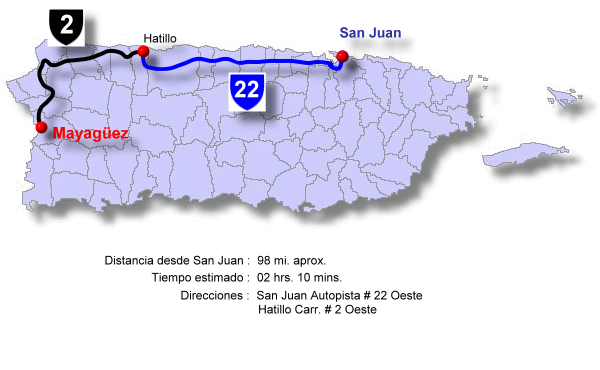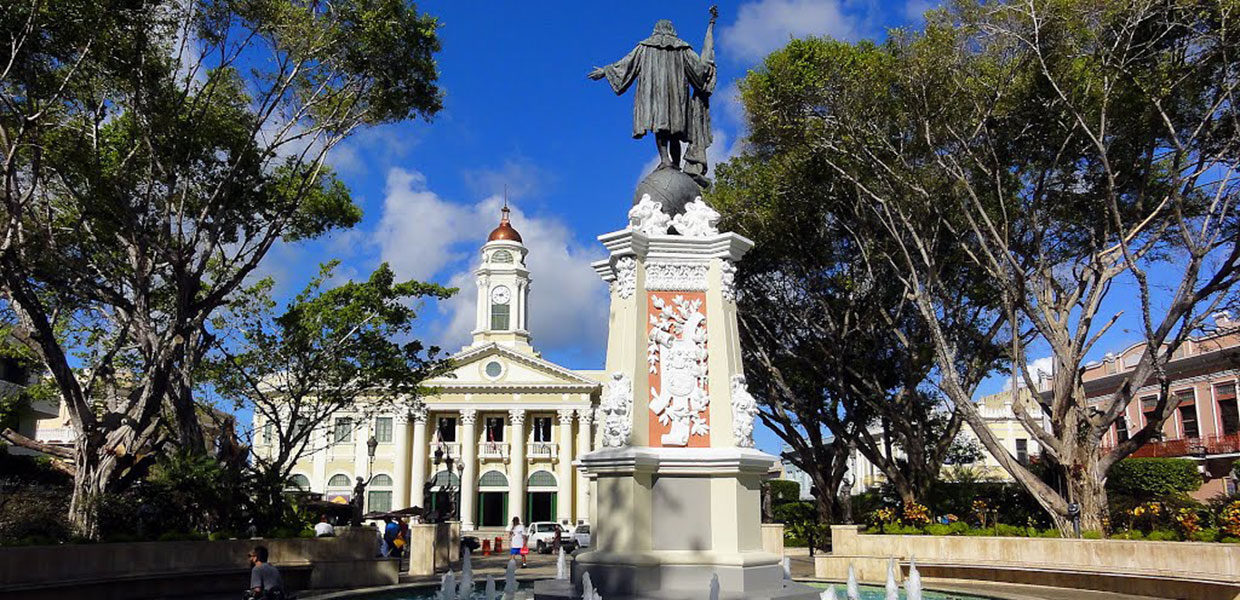
Mayagüez, Puerto Rico
Sultan of the West
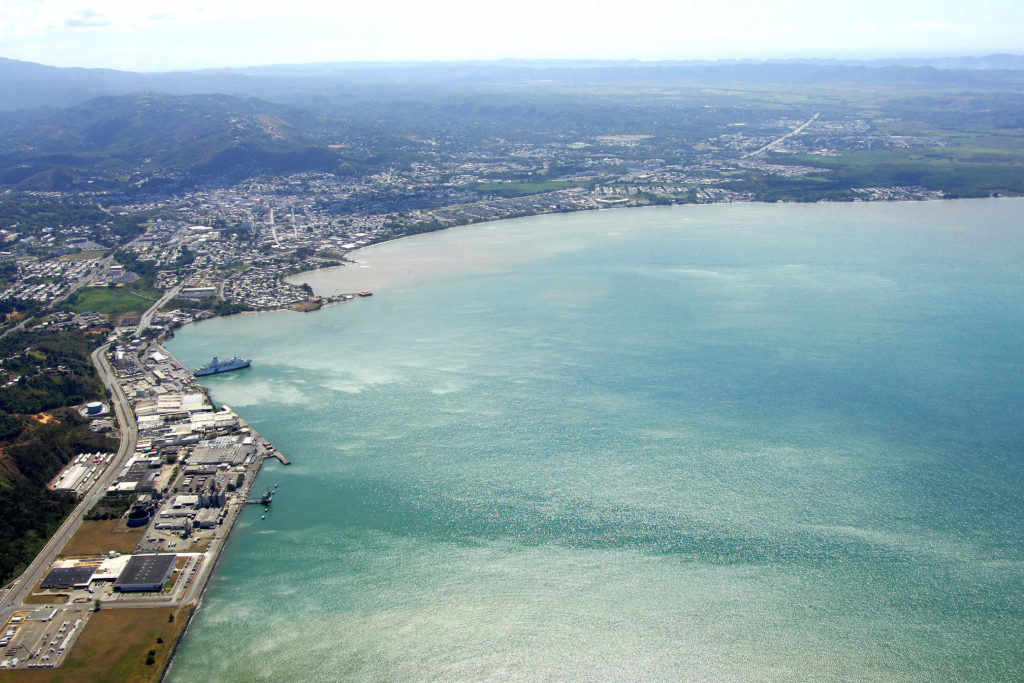
Mayagüez (mah-yah-GWES) known as “the Sultan of the West,” is a city where history, culture, and modernity intertwine. Its famous nickname comes from the legend of a woman with Arab features whose beauty captivated everyone who met her. Additionally, the city is recognized as “the City of Pure Waters,” “the Cradle of Eugenio María de Hostos,” “the City of Brazo Gitano,” “the City of the Indians,” and “the Town of the Mango.” Its patron saint, Our Lady of Candelaria, is celebrated with fervor through festivals that reflect the devotion and community spirit of Mayagüez’s residents.
Located on the western coast of Puerto Rico, Mayagüez borders Añasco and Las Marías to the north, Cabo Rojo, Hormigueros, and San Germán to the south, Maricao and Las Marías to the east, and the Mona Channel to the west. Its territory, mostly flat and fertile, benefits from abundant rainfall between May and November, which has historically supported agricultural development and economic prosperity.
The city stands out as an important educational and cultural center, home to the University of Puerto Rico at Mayagüez, known for its engineering and science programs, as well as the Dr. Juan A. Rivero Zoo, a space that attracts families and visitors from across the island. Additionally, Mayagüez is part of the “Porta del Sol” tourism plan, which promotes the natural resources, gastronomy, art, and culture of western Puerto Rico, solidifying its role as a regional development hub.
Mayagüez’s economic and cultural identity is also reflected in its distinctive local products, such as Franco’s famous “brazo gitano,” Cedó flans, and Fido’s “sangría.” Its port area continues to expand, strengthening trade and tourism while the city combines tradition with innovation.
According to the 2020 Census, the municipality has 73,077 inhabitants, while the metropolitan area of Mayagüez is home to approximately 207,877 people, consolidating the city as a key urban, economic, and cultural hub in western Puerto Rico. Today, Mayagüez presents itself as a vibrant city where history and modernity coexist, and culture is evident in every corner—from its architecture to its festivals and culinary traditions.
Foundation and Historical Evolution
Mayagüez was founded in 1760 by Faustino Martínez de Matos, Juan de Silva, and Juan de Aponte, established as “The Town of Our Lady of Candelaria.” The Taínos, governed by the chief Urayoán, inhabited the land and called the region Yagüez, which in their language meant “place of pure and clear waters.” With the arrival of the Spanish, the name evolved from Mayagüey to Mayagüex and finally to Mayagüez, although the city still retains the nickname “City of Pure Waters” due to the Yagüez River. The legend of the “Sultan of the West”—a woman with Arab features whose beauty captivated all—remained alive through centuries as part of local folklore.
By 1772, the population had 50 houses, 419 families, and approximately 1,800 inhabitants. The economy relied almost exclusively on agriculture, and the town developed in two centers: the town on the “high” lands and the beach. The port became a key export point for nearby towns like San Germán, Cabo Rojo, and Añasco.
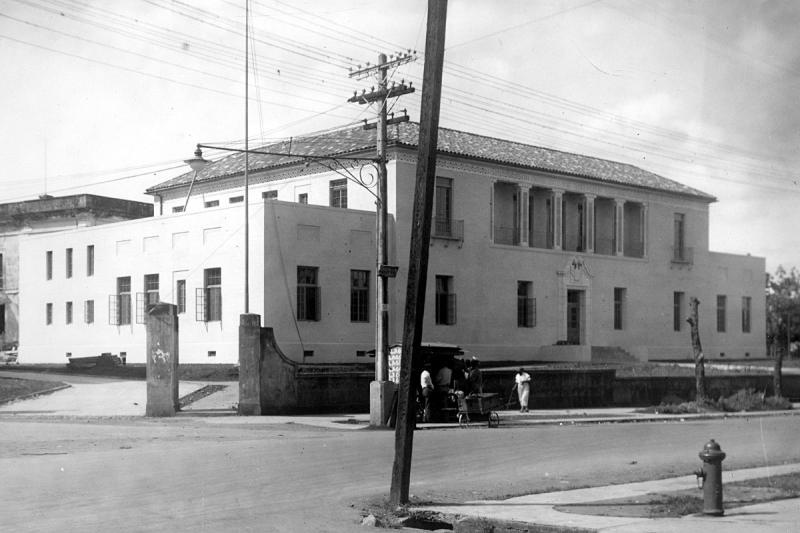
In 1836, Mayagüez was granted the title of Villa, giving it the right to have a town council and four towers on its coat of arms. However, in 1841 the city suffered its first major catastrophe, the Great Fire, which destroyed more than 90% of the houses and required the reconstruction of essential institutional buildings such as the Customs House, Town Hall, Infantry Barracks, Public Jail, and Military Hospital.
The advancement of communications and transportation marked the second half of the 19th century. In 1870, telegraph service between Mayagüez and San Juan was inaugurated, and in 1875 the Urban Railway of the Villa of Mayagüez began operating, a horse-drawn car that connected the town with the beach via Calle Méndez Vigo. Technical problems and the difficulty of its route led to its closure in 1886.
In 1895, the Mayagüez Tramway Corporation implemented a second tram system, extending to the Guanajibo neighborhood in 1897. This system operated until 1912, when it ceased operations. In December 1913, the third electric tram system, the Mayagüez Tramway Company, opened, offering greater capacity and running from the beach to the Balboa neighborhood along Calle Méndez Vigo.
On October 11, 1918, a magnitude 7.5 earthquake, accompanied by a tsunami of up to six meters, shook the city, causing severe damage to western Puerto Rico. During the 1920s, the city focused on reconstruction and development. However, with the arrival of automobiles and the expansion of motorized transport, the urban railway permanently ceased operations in 1926, marking the end of a historic era of transportation in Mayagüez.
Today, Mayagüez combines its rich historical heritage with modernity and development, establishing itself as a key educational, cultural, and economic center in western Puerto Rico while preserving traditions that reflect its unique identity and resilient spirit.
Location
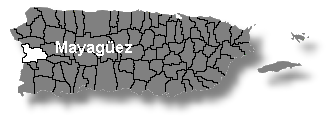 Mayagüez is located in the west coast. It is bordered by: Añasco and Las Marías on the north; by Red Cabo, Hormigueros and San Germán on the south; the Mona Passage on the west; and Las Marías and Maricao on the east.
Mayagüez is located in the west coast. It is bordered by: Añasco and Las Marías on the north; by Red Cabo, Hormigueros and San Germán on the south; the Mona Passage on the west; and Las Marías and Maricao on the east.
Area:
201.06 km² (77.6 square miles)
Population:
73,077 (2020 Census)
Population Density:
1,059 inhabitants per km²
Gentilicio:
Mayagüezanos
People are known as:
La Sultana del Oeste (The Sultan of the West)
La Ciudad de las Aguas Puras (The City of Pure Waters)
El Pueblo del Mango (The Town of the Mango)
Current Development and Growth
Economy and Development
Mayagüez continues to balance traditional industries with emerging sectors. Manufacturing, food, and beverages remain pillars, while technology, renewable energy, and innovative entrepreneurship grow as engines of development. The port area continues to expand, boosting regional trade and tourism.
Education and Science
The University of Puerto Rico at Mayagüez remains prominent in engineering, science, and sustainability. Its programs promote applied research, international collaboration, and entrepreneurship, establishing the city as an educational reference in western Puerto Rico.
Culture and Tourism
Emblematic festivals such as the Mayagüez Carnival, patron saint celebrations, and the Dance Festival have regained their in-person strength, complemented with digital innovations. Cultural and ecological tourism has become a strategic sector, attracting national and international visitors.
Infrastructure and Mobility
The modernization of roads, revitalization of the Malecón, and implementation of sustainable transport initiatives reflect a focus on efficient urban mobility and resilient development.
Population and Society
Mayagüez’s population remains stable. The city faces challenges such as migration and an aging population, but has a young sector highly engaged in education, research, and culture, strengthening its human capital.
Innovation and Environment
Mayagüez promotes sustainability projects including waste management, solar energy, and the conservation of rivers and wetlands. These initiatives protect local ecosystems and foster responsible, environmentally conscious urban development.
Wards: Mayaguez, Puerto Rico
Mayagüez is composed of 25 barrios, including:
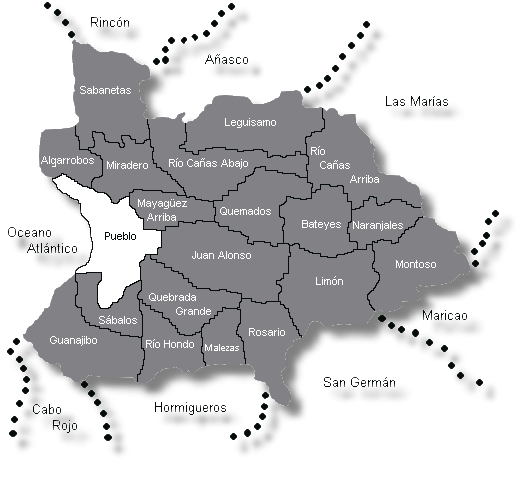
| Census 2020: Population by Wards - Mayagüez |
Population |
| Algarrobos | 4,792 |
| Bateyes | 968 |
| Guanajibo | 7,165 |
| Isla de Mona e Islote Monito | 0 |
| Juan Alonso | 1,371 |
| Leguísamo | 2,080 |
| Limón | 1,622 |
| Malezas | 964 |
| Mayagüez Town | 32,043 |
| Mayagüez Arriba | 6,098 |
| Miradero | 5,510 |
| Montoso | 1,118 |
| Naranjales | 1,197 |
| Quebrada Grande | 6,333 |
| Quemado | 3,017 |
| Río Cañas Abajo | 2,318 |
| Río Cañas Arriba | 1,495 |
| Río Hondo | 3,865 |
| Rosario | 1,289 |
| Sábalos | 10,271 |
| Sabanetas | 4,161 |
| Total | 73,077 |
Source: U.S. Census Bureau, 2020 Census
It is important to note that the municipality’s total population has decreased compared to the 2000 Census, when it was 98,434. This decline reflects a broader trend in Puerto Rico, where many areas have experienced population reductions due to various socioeconomic factors.
Patron Saint:
Our Lady of La Candelaria - "Nuestra Señora de La Candelaria"
Parish: Parroquia Nuestra Señora de La Candelaria
P.O. Box 220, Mayagüez, P.R. 00681
Phone: (787) 831-2444
Mass Scheduled:
Monday to Friday: 6:30am, 7:15am, 5:30pm
Saturday: 7:30am, 6:00pm, 7:30pm
Sunday: 6:30am, 8:00am, 9:30am, 11:00am, 5:00pm, 6:30pm
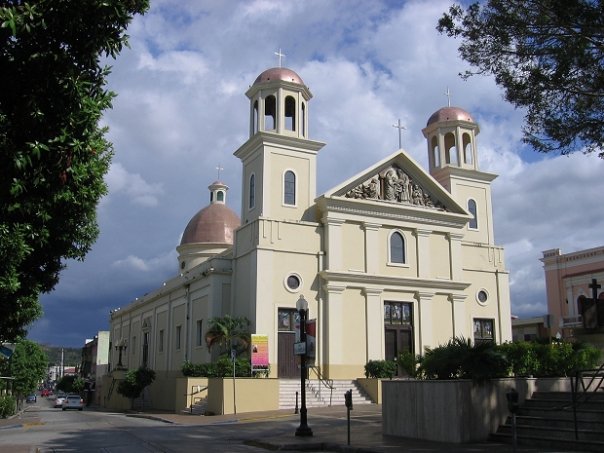
Topography
Mayagüez is part of the Western Coastal Valleys region. Its terrain is mostly flat, which supports agriculture and urban development. The higher areas are in the northeast and east, where the Urayoán Mountains, part of the central mountain range, rise. These mountains influence the microclimate and local hydrography.
The municipality also features beaches and coastal zones near the Malecón and the Yagüez River mouth, making Mayagüez strategic for fishing and recreational activities.
Hydrography
Several important rivers cross the municipality, fertilizing the land and supplying water to the population:
- Río Grande de Añasco: One of the longest rivers in western Puerto Rico, vital for agriculture and the local ecosystem.
- Río Guanajibo: Flows northwest and has been historically essential for port development.
- Río Yagüez: Historically significant; its clear waters gave the city its name.
Smaller streams and bodies of water form part of wetlands and coastal ecosystems essential for local biodiversity.
Climate
Mayagüez has a tropical humid climate typical of western Puerto Rico.
- Average annual precipitation: ~80 inches, mainly from May to November during hurricane season.
- Average temperature: 78 °F, with lows of 68 °F and highs of 88 °F.
- Weather hazards: The city can be affected by hurricanes and flooding due to its coastal location and rivers.
The climate supports tropical agriculture, including mangoes, sugarcane, and coffee in the mountainous areas.
Predominant Industries
- Manufacturing: Especially textiles and industrial products.
- Food: Production of flans, traditional sweets, and bakery products, including the renowned Franco Brazo Gitano bakery.
- Beverages: Cervecería India is a cornerstone of the local industry.
- Services: Education, healthcare, and tourism, with the University of Puerto Rico at Mayagüez and the Dr. Juan A. Rivero Zoo as key sites.
Average Income
The median weekly income for workers in Mayagüez is approximately $450–$500, reflecting the economic evolution and impact of sectors such as manufacturing and services.
Flag
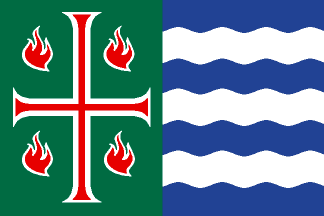 The flag of Mayagüez combines historical and geographical elements that reflect the city’s identity and heritage. The broad cross represents Christianity brought to the New World by Christopher Columbus, who often signed his documents with the phrase and symbol Cristo Ferens, meaning “He who carries Christ.” This historical reference highlights Mayagüez’s connection to the early European explorers and their influence on local culture.
The flag of Mayagüez combines historical and geographical elements that reflect the city’s identity and heritage. The broad cross represents Christianity brought to the New World by Christopher Columbus, who often signed his documents with the phrase and symbol Cristo Ferens, meaning “He who carries Christ.” This historical reference highlights Mayagüez’s connection to the early European explorers and their influence on local culture.
The blue and white waves symbolize the Atlantic Ocean, the Mona Channel, and the Yagüez River, recalling the city’s nickname as the “City of Pure Waters.” These elements not only emphasize the region’s riverine and maritime wealth but also reflect the importance of water in the city’s economic and social development.
Additionally, the flag evokes the third quarter of the coat of arms granted to Columbus by the Catholic Monarchs, harmoniously integrating historical heritage with local geography. Together, the flag of Mayagüez represents the pride of its people, their cultural identity, and the close connection between history, nature, and community that continues to define the city today.
Coat of Arms
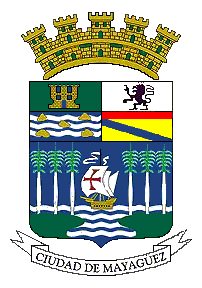 The Colombino Coat of Arms commemorates the discovery of Borinquén (today Puerto Rico) by Christopher Columbus during his second voyage to the New World in 1493. In the coat of arms, the lower point represents the mouth of the Yagüez River, from which the name Mayagüez is derived, highlighting the importance of this river in the history and development of the city.
The Colombino Coat of Arms commemorates the discovery of Borinquén (today Puerto Rico) by Christopher Columbus during his second voyage to the New World in 1493. In the coat of arms, the lower point represents the mouth of the Yagüez River, from which the name Mayagüez is derived, highlighting the importance of this river in the history and development of the city.
The elements of the coat of arms symbolize Columbus’s arrival on the western coast of the island and the interaction between European culture and Puerto Rico’s natural wealth. The colors and figures reflect the fertility of the land, the abundance of its river and agricultural resources, and the spirit of exploration that marked the beginning of the region’s modern history.
Beyond its historical significance, the coat of arms also represents the identity and pride of the people of Mayagüez, reflecting their cultural heritage, their connection to nature, and the strategic importance of the city as a port and economic center from colonial times to the present.
Events:
- Three Kings Day Festival – January
- Patron Saint’s Festival – January/February
- Romance on the Boulevard – February
- Bomba and plena festival – February/March
- Mothers’ day concert – May
- Fathers’ day concert – June
- Mayagüez Carnival – May
- Danza Festival – May
- Celebration of the founding of Mayagüez – September
- Crafts fair – November
- Christmas festivities – December
- Anniversary of the Puerto Rican flag – December
- Band concert at the Patriots’ Park – second Sunday of the month
- Pedestrian Mayagüez at Columbus Square – third Sunday of the month
These events strengthen cultural identity and attract locals and tourists alike.
Places of Interest
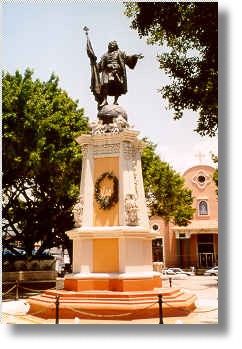
- Plaza de Colón and Eudaldo Báez García Boulevard
- Old Casino and Customs House
- Mayagüez Cultural Center: Public Library, Cultural Theater, and Tourism Office
- Cathedral of Our Lady of Candelaria
- Cervecería India and Agricultural Experimental Station
- Malecón and Linear Promenade
- University of Puerto Rico at Mayagüez
- Dr. Juan A. Rivero Zoo
- Planetarium, Casa Grande Historical Museum, Eugenio María de Hostos Museum
- Monument to Eugenio María de Hostos
- Mayagüez Recreation and Sports Palace
- Parque de Próceres Puertorriqueños and Rosa M. Carrero Millennium Children’s Park
Historical:
- Eugenio María de Hostos (1839–1903): Educator, philosopher, writer, and patriot advocating social justice, universal education, women’s rights, and Puerto Rican independence.
- Federico Asenjo Arteaga (1870–1930): Journalist and writer documenting Puerto Rican culture.
- Alejandrina Benítez de Gautier (1819–1879): Poetess and mother of José Gautier Benítez.
- Pedro Gerónimo Goyco (1825–1886): Physician, educator, politician, and social reformer.
- Simón Madera (1850–1910): Musician and composer.
- Rafael Martínez Nadal (1877–1941): Politician, orator, and writer.
- Roberto Sánchez Vilella (1913–1997): Governor of Puerto Rico, promoted modernization and urban development.
- José María Monge (1870–1930): Journalist and poet.
- Salvador Perea (1903–1985): Historian, author of History of Puerto Rico: 1537–1700.
- Juan Ríus Rivera (1848–1924): Cuban Liberation Army general.
- Josefina Rivera de Álvarez (1881–1961): Educator and author.
- Salvador Tió (1911–1989): Journalist and cultural advocate.
Contemporary:
- Anaida Hernández (b. 1954): Artist, sculptor, painter, and professor addressing gender violence in Caribbean and Latin American art.
- Emmanuel Rivera: Professional baseball infielder, represented Mayagüez in the 2025 Caribbean Series.
- Wilkins Vélez (Wilkins) (b. 1953): Pop singer and composer.
- J.J. Barea: Former NBA basketball player, primarily with the Dallas Mavericks.
- María Celeste Arrarás: Television journalist and host.
- Gricel Mammery: Television presenter and comedian.
These figures illustrate the talent and influence of Mayagüez residents across diverse fields, continuing to inspire future generations.
Public Schools sorted by educational levels.
Mayagüez Region
Mayagüez District
| Name | Level | Telephone | Address |
| Elementary | |||
| CASTILLO | K-6 | (787) 265-8344 | PO Box 3050, P.R. 00681-0000 |
| CENTRO ESTIMULACIÓN TEMPRANA | EE | (787) 832-1505 | Carr. # 2, P.R. 00680-0000 |
| CHARLES T. IRIZARRY | K-6 | (787) 832-4456 | PO Box 3050, P.R. 00681-0000 |
| CONCORDIA | K-3 | (787) 832-2081 | Bo. El Seco, P.R. 00680-0000 |
| CONSUELO PÉREZ CINTRÓN | K-6 | (787) 832-2055 | PO Box 6757, P.R. 00681-6757 |
| CRUCES | K-6 | (787) 833-2985 | PO Box 3050, P.R. 00681-0000 |
| CUESTA DE PIEDRAS | K-6 | (787) 832-9018 | PO Box 8010, P.R. 00680-0000 |
| DAVID G. FARRAGUT | K-6 | (787) 832-3344 | PO Box 2201, P.R. 00681-0000 |
| FEDERICO ASENJO | 3-6 | (787) 832-1305 | PO Box 7997 Suite 84, P.R. 00681-0000 |
| FRANCISCO BACO SORIA | K-6 | (787) 832-2314 | PO Box 4478, P.R. 00681-0000 |
| FRANCISCO VICENTY | K-2 | (787) 832-2310 | PO Box 797 Suite 125, P.R. 00681-0000 |
| FRANKLIN D. ROOSEVELT | K-6 | (787) 832-0482 | 182 Calle, P.R. P.R. 00680-0000 |
| LUIS MUÑOZ RIVERA | K-6 | (787) 834-7700 | PO Box 3050, P.R. 00681-0000 |
| MALEZAS | K-6 | (787) 833-8283 | PO Box 3050, P.R. 00681-0000 |
| MANUEL FERNÁNDEZ JUNCOS | K-6 | (787) 832-2233 | PO Box 155, P.R. 00680-0000 |
| MARIA LUISA ARCELAY | K-6 | (787) 833-8845 | PO Box 1647, P.R. 00681-1647 |
| MARIANO RIERA PALMER | K-6 | (787) 832-5262 | 257 Oeste, P.R. 00680-0000 |
| MIRADERO II | K-5 | (787) 832-0492 | Carr. 108 #1584, P.R. 00680-7504 |
| RAFAEL MARTÍNEZ NADAL | K-6 | (787) 832-2002 | PO Box 4427, P.R. 00680-0000 |
| RAMÓN VALLE SEDA | PK-6 | (787) 832-5105 | PO Box 812, P.R. 00681-0000 |
| RÍO CAÑAS ARRIBA | K-6 | (787) 832-4620 | PO Box 3050, P.R. 00680-0000 |
| SABANETAS MANÍ | K-5 | (787) 832-5080 | Calle Aduna 257 Suite 344, P.R. 00680-0000 |
| SEGUNDO RUIZ BELVIS | PK-6 | (787) 832-5078 | PO Box 3205, P.R. 00681-0000 |
| THEODORE ROSEVELT | K-6 | (787) 832-2204 | 153 Calle Pablo Casals, P.R. 00681-0000 |
| Intermediate | |||
| ELPIDIO H. RIVERA | 7-9 | (787) 833-5560 | PO Box 3050, P.R. 00681-3050 |
| JOSÉ GAUTIER BENÍTEZ | 7-9 | (787) 834-0900 | PMB 772 PO Box 7997 Suite 72, P.R. 00681-0000 |
| MANUEL A. BARRETO | 7-9 | (787) 832-3046 | PO Box 1260, P.R. 00681-1260 |
| MARIA DOLORES FARIA | 7-9 | (787) 834-9289 | Calle Candelaria, P.R. 00680-0000 |
| Secondary | |||
| ERNESTO RAMOS ANTONINI (MÚSICA) | 3-12 | (787) 834-3177 | PO Box 1048, P.R. 00681-1048 |
| ESTEBAN ROSADO BÁEZ | 7-9 | (787) 831-6199 | Suite 294, P.R. 00681-0000 |
| LA SOLEDAD | 6-9 | (787) 834-8944 | 153 Parcelas Soledad, P.R. 00680-0000 |
| RÍO CAÑAS ABAJO | K-9 | (787) 831-0050 | PO Box 3050, P.R. 00681-0000 |
| SU FELISA RINCÓN DE GAUTHIER | K-9 | (787) 831-5066 | PMB 356, P.R. 00681 |
| High School | |||
| CROEM | 9-12 | (787) 837-3720 | PO Box 1550, P.R. 00681-1550 |
| DR. PEDRO PEREA FAJARDO | 10-12 | (787) 833-0865 | PO Box 1330, P.R. 00681-1330 |
| EUGENIO MARIA DE HOSTOS | 10-12 | (787) 834-0600 | PO Box 130, P.R. 00681-0130 |
| SUPERIOR JOSÉ DE DIEGO | 10-12 | (787) 833-4804 | Apartado 8124 Marina Station, P.R. 00681-0000 |
Hymn:
By Luciano Quiñones
Mi patria es un oasis,
un jardín de gran belleza,
donde artistas y poetas
se llenan de inspiración;
y tiene en el Oeste,
una fulgurante estrella,
un pedacito de cielo,
parte del reino de Dios.
Hoy quiero regalarle
a esta ciudad de hermosura,
La Sultana del Oeste,
la del sabor a mangó;
mi más lírica alabanza,
mi poesía más fina y pura,
y una melodía bordada
con hilos del corazón.
¡Mayagüez! ¡Mayagüez!
Ciudad de las aguas puras,
valles y montes de ensoñación,
baja cantando tu río
a tu apacible bahía
donde al fin de cada día
se acuesta a dormir el Sol.
¡Mayagüez! ¡Mi Mayagüez!
Que orgullo para nosotros
tu historia es,
desde el humilde Taíno
que bautizó al Río Yagüez,
a Eugenio María de Hostos
que inmenso fue.
Eres cuna de cultura,
crisol de sabiduría,
la Virgen de la Candelaria
dotó a tus damas
de gran belleza y de simpatía.
Eres el lugar perfecto,
del Paraíso el Edén;
de orgullo se hinche mi pecho
para decirte: ¡Dios te bendiga,
mi Mayagüez! ¡Mayagüez!

